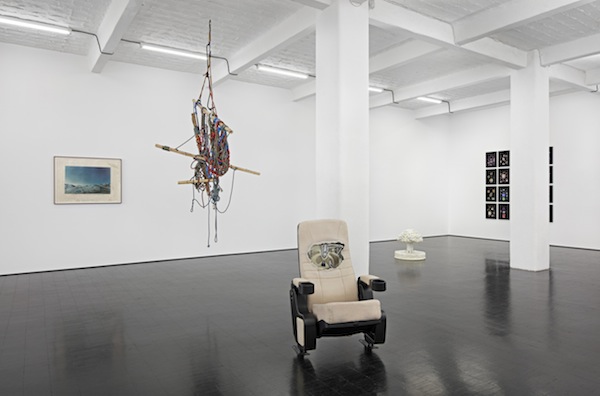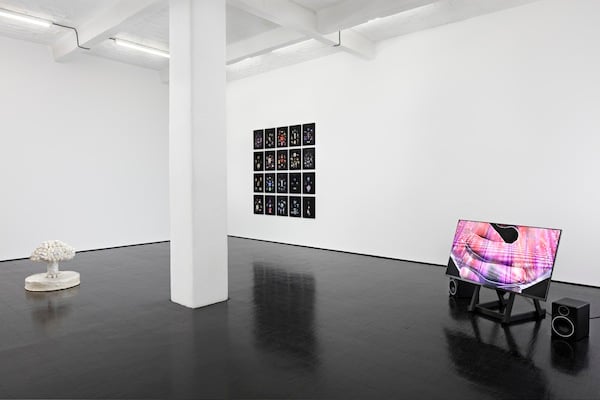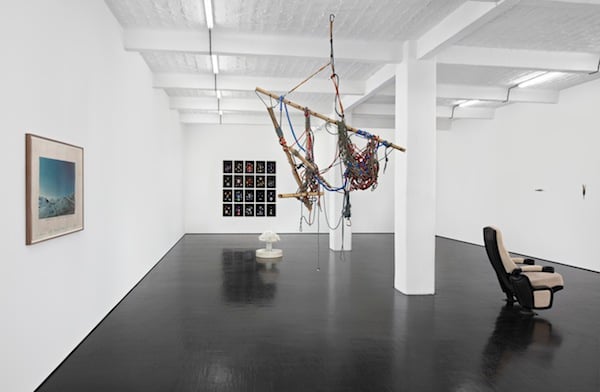Reviews
At Barbara Weiss, The Hellstrom Chronicle Pits Man Against Nature
The group show is inspired by a 1971 dystopian pseudo-documentary.

The group show is inspired by a 1971 dystopian pseudo-documentary.

Alyssa Buffenstein

It’s not true that cockroaches can survive a nuclear blast, but the idea that insects will inherit the earth is a notion posited by the 1971 film The Hellstrom Chronicle. The documentary-style, horror-inspired movie is narrated by a fictional scientist named Dr. Nils Hellstrom, who prophesies a future where insects will outlive other life on earth, due to their ability to adapt to even humans’ best efforts to ruin the planet.
Dr. Hellstrom, who at one point hints at the possibility that his insect obsession stems from schizophrenia, demonstrates his delusions over sumptuous images of insects eating, fighting, and procreating, shot beautifully and in extreme close-up. The film inspired the current show of the same name at Barbara Weiss gallery in Berlin, a group show of artists Dora Budor, Anders Clausen, Tobias Madison and Kaspar Müller, Dennis Oppenheim, Mai-Thu Perret, Suzanne Treister, Susanne M. Winterling, and Young Girl Reading Group.
In the movie, Dr. Hellstrom ominously compares the selfish, instinctual, and sometimes-violent behavior of nature to the emotional behavior of humans, in an attempt to prove that evolution will weed out mankind.
At Barbara Weiss gallery’s “Hellstrom Chronicle,” artist Suzanne Treister offers a new way to compare nature and humanity: where humans have emotions, corporations do not, and instead function more like insect hives—or maybe powerful psychoactive plants. Triester’s piece at Barbara Weiss is a collection of 20 prints, each bearing a name of one of the world’s top 20 companies according to the Financial Times’ Global Financial Index. Below names like Apple, Google, Shell, Nestlé, and Johnson & Johnson, Triester juxtaposes iridescent images of psychoactive plants. The plants in each print have a gematria number—a numerical significance based on the letters in their scientific names—that corresponds to the company’s ranking. The psychoactivity of the plants implies a similar ability of the companies to affect the population’s state of consciousness.

Installation view. Image courtesy the artists and Barbara Weiss, Berlin.
Like any good horror film, The Hellstrom Chronicle movie relies on music to heighten suspense. The gallery show features a video called Vertex by Susanne M Winterling, featuring a pair of disembodied Mickey Mouse-gloved hands twiddling their thumbs. The white gloves run through a series of insect close-ups, before the screen fades to black. Running on loop, the hands reappear with a jarring stab noise—the jump scare that you don’t even realize is coming because you’re too busy looking at other artworks. The video’s sound imbues the entire gallery space with a cinematic state of anxiety.
Dealing with meta-themes of movie-watching and post-humanism is artist Dora Budor, who created a reclining chair from the cyborg chest prosthetics worn by Bruce Willis in the movie Surrogates. In the 2009 sci-fi film, humans live through cyborg surrogate bodies, never having to leave the comfort and safety of their homes. Budor’s chair, Mental Parasite Retreat 1, is made of flesh-colored leather, as if the human watching their own life play out through an alias (or, for that matter, on a TV, movie, or computer screen), has become the chair in which they sit. But in the center of the chair, the cyborg parts are revealed underneath a patch of Willis’s surrogate’s ripped-off skin. The chair is simultaneously a place for watching and the surrogate itself, implicating both reality and science-fiction.

Installation view. Image courtesy the artists and Barbara Weiss, Berlin.
A series of single bird feathers coated in pigments and metal by Anders Clausen explores potential clashes between man and nature. Lined up in a row across one of the gallery’s walls, the works are the most delicate and subtle in the show. One galvanized feather hung horizontally on the wall is completely coated in shining metal, with a swipe of Kawasaki green lacquer—the paint used to touch up motorcycles of the color when the paint gets scratched off. A zig-zag pattern is carefully cut out of the top half of the feather, adding a sharp, geometric contrast to its curved, organic shape. After a number of industrial interventions, the soft animal material becomes a rigid, dagger-like object.
Inspired by science-fiction storytelling, the works in Barbara Weiss gallery’s “The Hellstrom Chronicle” weave a multi-faceted narrative of human intervention into nature, and questions the relationships and assumed hierarchies between animal and plant life, and humanity and its capability for technological innovation.
The Hellstrom Chronicle is on view at Barbara Weiss, Berlin until August 6.